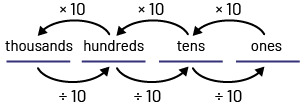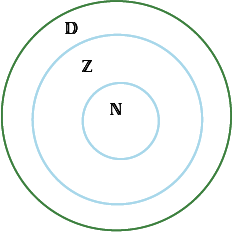C1.4 Create and describe patterns to illustrate relationships among whole numbers and decimal tenths.
Skill: Creating and Describing Number Patterns to Represent Relationships Between Whole and Decimal Numbers
The base ten system includes multiple patterns that help deepen understanding of number relationships.
From a young age, students count in increments of 1, 2, 5, 10, 25, etc. Skip counting and writing the resulting number pattern helps students see relationships between numbers. It is important to continue to have students count in the junior grades with different types of numbers, such as large whole numbers (for example, counting by groups of 500, 1500), fractions (for example, counting by groups of "one-third" by saying 1 one-third, 2 one-thirds, 3 one-thirds, 1, etc.), and so on, up to at least 5) and decimal numbers (tenths or hundredths). The way numbers are written when students recite them is intentional and should be planned to show relationships.
Patterns and pattern rules can be used to understand the relationships between whole numbers and decimal numbers.
Source: Ontario Curriculum, Mathematics Curriculum, Grades 1-8, 2020, Ontario Ministry of Education.
Understanding the relationships between the value of digits and their position in a number is essential to the development of number sense. In the Primary Division, students develop an understanding of the relationships between the place values of ones, tens and hundreds. However, in the Junior Division, they do not automatically transpose this understanding to larger numbers. This is why teachers must be sure that students understand that the value of any position in a number is always 10 times greater than the value of the position immediately to the right, and 10 times less than the value of the position immediately to the left. It is also important to examine the relationships (for example, 100 times or 1,000 times greater or less than) between place values in order to develop students' deep number sense, including sense of large numbers.
Students should also recognize, for example, that a ten thousand represents a grouping of 100 hundreds, a grouping of 1,000 tens, or a grouping of 10 000 ones. These groupings allow students to recognize equivalent representations of numbers (for example, 2,534 is equal to 25 hundreds and 34 ones).
It is possible to observe patterns and relationships by decomposing a number using place value.
Example
The number of ones increases by 10 when the number of tens decreases by 1.
| Decimal number | Tens | Ones |
|---|---|---|
| 56 | 5 | 6 |
| 56 | 4 | 16 |
| 56 | 3 | 26 |
| 56 | 2 | 36 |
| 56 | 1 | 46 |
| 56 | 0 | 56 |
Place value relationships play an important role when doing estimation, rounding, or decomposition. In addition, they are the basis for multiplication and division by a multiple of 10.
Source: translated from Guide d’enseignement efficace des mathématiques de la 4e à la 6e année, Numrération et sens du nombre, Fascicule 1, Nombres naturels, p. 44-45.
Example
When the factor that is multiplied by 10 increases by 1, the product increases by 10.
When the dividend decreases by 10, the quotient decreases by 1.
| × 10 | ÷ 10 |
|---|---|
| 1 × 10 = 10 | 100 ÷ 10 = 10 |
| 2 × 10 = 20 | 90 ÷ 10 = 9 |
| 3 × 10 = 30 | 80 ÷ 10 = 8 |
| 4 × 10 = 40 | 70 ÷ 10 = 7 |
| 5 × 10 = 50 | 60 ÷ 10 = 6 |
| 6 × 10 = 60 | 50 ÷ 10 = 5 |
| 7 × 10 = 70 | 40 ÷ 10 = 4 |
| 8 × 10 = 80 | 30 ÷ 10 = 3 |
| 9 × 10 = 90 | 20 ÷ 10 = 2 |
| 10 × 10 = 100 | 10 ÷ 10 = 1 |
Place Value Relationships in Decimal Numbers
The beginning of the junior grades is the first time students study the decimal numbers. Students need to deepen their understanding of the place value of numbers and the relationships between place values. Decimal numbers are part of everyday life and understanding the place values to the right and left of the decimal point is essential.
It is important that students also grasp the multiplicative relationship by 10 that exists between adjacent position values. Their understanding of this relationship has previously been developed in the study of whole numbers, that each position has a value 10 times greater than the one to its right and 10 times smaller than the one to its left.
 Image Position value relationships in decimal numbers: thousands, hundreds, tens, units. Arrows point to the right to represent bonds multiplied of ten. Arrows point to the left to represents bonds divided by ten.
Image Position value relationships in decimal numbers: thousands, hundreds, tens, units. Arrows point to the right to represent bonds multiplied of ten. Arrows point to the left to represents bonds divided by ten.
This multiplicative relationship is also true for decimal positions.
 Image Position value relationships in decimal numbers: thousands, hundreds, tens, units, tens, hundreds, thousands. Arrows point to the right to represent bonds multiplied of ten. Arrows point to the left to represents bonds divided by ten.
Image Position value relationships in decimal numbers: thousands, hundreds, tens, units, tens, hundreds, thousands. Arrows point to the right to represent bonds multiplied of ten. Arrows point to the left to represents bonds divided by ten.
Students can develop an understanding of this by doing groupings using base ten materials. The idea is to demonstrate that just as 10 ones yield 1 ten, 10 tenths yield 1 one and 10 hundredths yield 1 tenth, and so on.
Example 1
The number of tenths increases by 10 when the number of ones decreases by 1.
| Decimal Number | Tens | Ones | Tenths |
|---|---|---|---|
| 56.4 | 5 | 6 | 4 |
| 56.4 | 5 | 5 | 14 |
| 56.4 | 5 | 4 | 24 |
| 56.4 | 5 | 3 | 34 |
| 56.4 | 5 | 2 | 44 |
| 56.4 | 5 | 1 | 54 |
| 56.4 | 5 | 0 | 64 |
The student can create patterns of related operations to illustrate the relationship between addition and subtraction facts.
Example 2
When the first term, in addition, increases by 0.1 and the second term decreases by 0.1, the sum is always the same throughout the series of related operations.
When the second term, in subtraction, decreases by 0.1, the difference increases by 0.1 throughout the series of related operations.
| Addition | Subtraction |
|---|---|
| 74.0 + 0.8 = 74.8 | 74.8 - 0.8 = 74.0 |
| 74.1 + 0.7 = 74.8 | 74.8 - 0.7 = 74.1 |
| 74.2 + 0.6 = 74.8 | 74.8 - 0.6 = 74.2 |
| 74.3 + 0.5 = 74.8 | 74.8 - 0.5 = 74.3 |
| 74.4 + 0.4 = 74.8 | 74.8 - 0.4 = 74.4 |
| 74.5 + 0.3 = 74.8 | 74.8 - 0.3 = 74.5 |
| 74.6 + 0.2 = 74.8 | 74.8 - 0.2 = 74.6 |
| 74.7 + 0.1 = 74.8 | 74.8 - 0.1 = 74.7 |
| 74.8 + 0.0 = 74.8 | 74.8 - 0.0 = 74.8 |
The multiplicative relationship by 10 between positional values can also be explored with metric units of measurement, since these are designed in terms of the base ten (for example, 10 cm yields 1 dm, 10 mm yields 1 cm). Monetary units are best avoided in early conceptual learning because, while there is indeed a multiplicative relationship by 10 between the value of some coins (for example, between pennies and dimes or between dimes and $1s), it is quite different between other coins (for example, between nickels and $1s).
The calculator offers interesting ways to explore the multiplicative relationship by 10. For example, students can perform the operation 0.1 + 0.1, predict the answer, and continue the series until they arrive at 0.1 + 0.1 + 0.1 + 0.1 + 0.1 + 0.1 + 0.1 + 0.1 + 0.1. Before adding 0.1 one last time, a discussion is needed to explore students' assumptions and reasoning, and to ensure that they recognize that 10 tenths is 1 one. Students can repeat the activity with the series 0.01 + 0.01 +… or 0.001 + 0.001 +…or with other decimal numbers.
Source: translated from Guide d'enseignement efficace des mathématiques de la 4e à la 6e année, Numération et sens du nombre, Fascicule 3, Nombres décimaux et pourcentages, p. 51-53.
Knowledge: Whole Numbers
Whole numbers are all positive integers, including zero (for example, 0, 2, 17, 36, 134). There is an infinite number of whole numbers.
Our base ten system is based on groupings (groups of 10).
- The ones are grouped in groups of 10 to form the tens.
- The tens are grouped in groups of 10 to form the hundreds, and so on.
Source: translated from L’@telier - Ressources pédagogiques en ligne (atelier.on.ca).
Knowledge: Decimal Numbers
Decimal Numbers (D)
The type of decimal numbers that students study in the junior grades either terminate (e.g., 4.5) or repeat (e.g., 1/3 = 0.3333...). Whole numbers can be expressed as a decimal number (e.g., 52 = 52.0). Fractions can be expressed as a decimal number (e.g., 1/2 = 0.5).
All whole numbers are integers. Integers can be expressed as decimal numbers. The relationship between the sets of numbers can be represented by the following Venn diagram.

Note: Decimal numbers are not a separate set of numbers. Whole numbers and fractions can be represented in decimal form. The name decimal number simply means that the expression of the number contains a decimal point.
Source: translated from Guide d'enseignement efficace des mathématiques de la 4e à la 6e année, Numération et sens du nombre, Fascicule 2, Fractions, p. 42.
